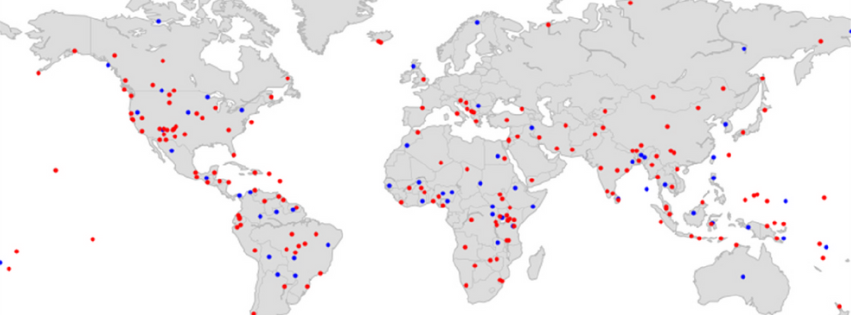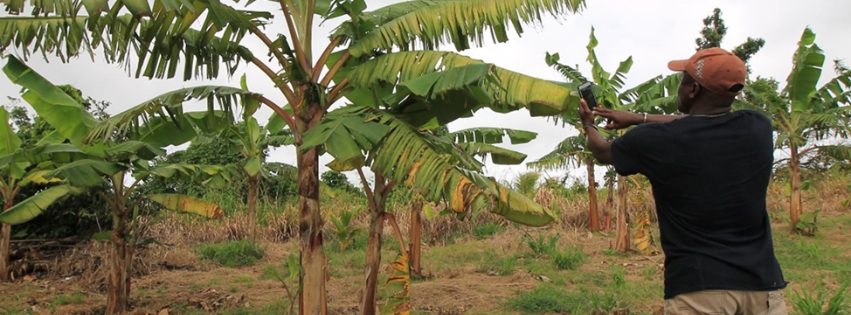Francine Barone
This summary features some of the exciting research accomplished using HRAF data from the eHRAF World Cultures and eHRAF Archaeology databases as well as Explaining Human Culture (EHC), Teaching eHRAF, and other open access materials from HRAF. If you would like to stay informed of the latest eHRAF research, sign up here to receive an email when our next summary is available.
***
For our first HRAF Academic Quarterly of 2024, we are pleased to share 16 publications since the start of the year. New research in cultural evolution this quarter covers a fascinating mix of topics including punishment; the effect of alcohol on political complexity; mythical monsters; the control of women’s sexuality; and Indigenous ethnobotany. Two studies on hunter-gatherers look at foragers’ relationships to animals and to trees.
From medicine, a systematic review of the cultural significance of exfoliated teeth brings eHRAF insights to pediatric dental care, and a review of nutritional anthropology explores critiques of the “Paleo Diet”, which was originally a product of analyses of HRAF data. In education, there is a new volume on child development and education in indigenous communities as well as a UNICEF study on child rights.
eHRAF is once again front and center in discussions of ethnographic, comparative and cross-cultural databases and methodologies. In addition, a case study of building a collaborative community dictionary in the Philippines highlights how HRAF’s subject thesaurus, the Outline of Cultural Materials (OCM), has important applications in linguistics, lexicography and community engagement.
HRAF staff members Ian Skoggard and Samantha King presented their research at the 84th Annual Meeting of the Society for Applied Anthropology in Santa Fe, Arizona.
Cultural Evolution & Cross-Cultural Research
Social substitutability across features of human socioecology
Grégory Fiorio, Zachary H. Garfield
In many societies, third parties may be held liable to punishment even though they did not take part in the original offence. These retributive practices, commonly referred to under the label of social substitutability, are frequently documented in the historical and ethnographic records. While previous cross-cultural research has focused on blood feuds and retributive collective violence, less attention has focused on explaining why and when third parties would be punished for offences they did not commit. We review research on social substitutability, attempt at clarifying the hypothesis space to account for its cognitive and ecological underpinnings, and offer a preliminary account for its cross-cultural variation. We integrate existing society-level measures from cross-cultural data to investigate the socioecological covariates of social substitutability. Our results suggest that systematic enforcement of social substitutability is more likely to be documented in kinship intensive societies, yet shows no substantial variation across subsistence types and continental regions. Moreover, we fail to find clear evidence that residence patterns facilitating the emergence of fraternal interest groups favor the emergence of social substitutability. Taken together, our review and results suggest that a closer understanding of local social networks and organizations may be a fruitful way to unravel cross-cultural variability in the propension to punish uninvolved third parties.
Did alcohol facilitate the evolution of complex societies?
Václav Hrnčíř, Angela Chira, Russell Gray
The size and complexity of human societies increased dramatically over the Holocene. Researchers have proposed a variety of potential drivers of this major transition, including our predilection for alcoholic beverages. This “drunk” hypothesis argues that drinking alcohol facilitated the rise of complex societies because it promotes social bonding and enhances human creativity. However, systematic cross-cultural evidence for the claim is lacking. Here we test this hypothesis with a global sample of 186 largely non-industrial societies. We find a positive (albeit modest) relationship between the presence of indigenous alcoholic beverages and the level of political complexity, even after controlling for several potential confounders, including common ancestry, spatial proximity, environmental productivity and agricultural intensity. Furthermore, we find that the largest effect of alcohol on political complexity is in less integrated societies, such as “acephalous” societies and “simple chiefdoms”. Our results support the idea that group-level social benefits of alcohol tended to outweigh its disruptive effects, at least in the case of traditional low-alcohol beverages, and thus positively contributed to the evolution of human societies.
Explaining Mythical Composite Monsters in a Global Cross-Cultural Sample
Timothy W. Knowlton, Seán G. Roberts
Composite beings (“monsters”) are those mythical creatures composed of a mix of different anatomical forms. There are several scholarly claims for why these appear in the imagery and lore of many societies, including claims that they are found near-universally as well as those arguments that they co-occur with particular sociocultural arrangements. In order to evaluate these claims, we identify the presence of composite monsters cross-culturally in a global sample of societies, the Standard Cross-Cultural Sample. We find that composite beings are not universal, and that their presence or absence co-varies most significantly with social stratification and transportation technology. This supports hypotheses that the cultural evolution of composite monsters is driven by human concerns with social distinctions within societies as well as increased contact with distant peoples.
Control of Female Sexual Behaviour: An Investigation using the Standard Cross-Cultural Sample
Kayleigh Grossman (MScRes Thesis, University of Kent. NB: embargoed until January 2027)
The control of female sexual behaviour has been suggested to be a mating strategy used by both men and women to mitigate intrasexual competition. […] Previous research has tested these theories but have focused on a small aspect of female sexual behaviour, premarital sexual permissiveness. This thesis aims to expand on this research by examining the question: Do men and women control female sexual behaviour through promoting negative attitudes and beliefs on different aspects of female sexual behaviour? To charter the extensive variation in attitudes and beliefs on female sexual behaviour that is present in societies a thorough literature search was conducted of the Human Relations Area Files. This revealed 10 thematic areas including attitudes towards menstruation, virginity and adultery and sexual pleasure. Whyte’s alternative case sample of the Standard Cross-Cultural Sample was used to test the effectiveness of circumstances that might incentivise men and women to control several ‘aspects’ of female sexual behaviour[…] Results from Ordinal Logistic Regression showed that societies who had direct inheritance of resources and control of property by women were more likely to enact control over women’s sexual behaviour. The question of whether men and women control female sexual behaviour through different mechanisms was also confirmed.
Pamiva – Hijos de la Anaconda Ancestral: El uso y conocimiento de las plantas como herramienta para comprender las transformaciones sociales en la etnia Cubeo entre 1939 y 2023
Maria Daniela Perdomo Cáceres (MSc Thesis, Universidad de Caldas)
Ethnobotany has emerged as a crucial field of interest, especially in Colombian regions rich in biodiversity and culture, such as Vaupés. This research focuses on understanding the cultural transformations that have influenced the knowledge and use of plants among the Cubeo ethnic group, specifically in the community of Wacurabá in the Cuduyarí river, in the period from 1939 to 2023, through a transtemporal analysis. The starting point was Irving Goldman’s research carried out in 1939 in the same area. It identified 14 plants classified into three categories of use, with poisons being the most represented (57%), followed by social and material use. Over eight decades, all of these plants presented changes in their use, some of the causes being historical events that occurred in this area such as: religious missions, extractive economies, illegal economies, armed violence and incursion of new social projects. Ultimately, it is concluded that rubber tapping and religious missions were the most impacting events in the change of this knowledge. In addition, it is highlighted that with these events the importation and selection of knowledge have been the main sources of transformation in cultural dynamics. This study provides a perspective on botanical knowledge in the Cubeo ethnic group and its relationship with the transformation of cultural dynamics.
The author of this study used eHRAF World Cultures to search for ethnobotanical information for the Tukano-speaking peoples of the Cubeo ethnic group. The ability to find results about this variable across different time periods enabled them to establish when specific plants were first used by the indigenous Cubeo people in 1939.
Hunter-Gatherers
Concern for Animals among Hunter-Gatherers
Barton A. Thompson
This study examined the degree to which hunter-gatherers exhibited concern for animals. Six types of concern (sympathy, consequential, identity-based, respectful, protective, and indifference) were assessed in twenty-eight hunting-gathering groups from around the world using eHRAF World Cultures. Findings demonstrated that sympathy for animal agents was low, and indifference was high. High levels of consequential concern and moderate levels of identity and respectful concern were evident. Protective concern was found in about a third of the groups. Higher levels of concern were experienced when the animals were perceived as either pseudo-humans or pseudo-spirits. The transition from hunter-gatherer to agro-industrial lifestyle has led to fewer interactions and less overall concern for animals, but it has not produced a decrease in sympathy for animal agents, which was already relatively low among foragers. These findings lend support to the theory that humans did not evolve to experience high levels of sympathetic concern for animals as animal agents, and it helps to explain the widespread present exploitation of animals. It also demonstrates that concern can and does arise when animals take on pseudo-human agency.
Making places in the world: An ethnographic review and archaeologic perspective on hunter-gatherer relationships with trees
Paula C. Ugalde, Steven L. Kuhn
Despite the importance of trees in the lives of hunter-gatherers, the economic, cultural, and spiritual roles of trees have been seldom explored empirically or theoretically. What research exists on the topic has mostly focused on economic aspects, especially firewood management, consumption of edible tree products, and tool manufacture. Here, we summarize data collected from 104 ethnographies on hunter-gatherers to analyze their relationships with trees. We focus principally on 14 societies from South America and two living in deserts in Australia and Africa, to achieve an environmental comparative perspective. We demonstrate that trees provided hunter-gatherers with multiple benefits that were not based on extraction, but also on conservation. Among these benefits are shade, temperature regulation, protection, recreation, using trees as parts of habitation structures, and soil fertilization. With these data we examine the roles that trees might have played as important constituents of places. We propose that it is possible to assess human-tree relationships at different geographic scales archaeologically. Moreover, based in the collected ethnographic data, archaeologists should consider past distribution of trees to understand hunter-gatherer settlement patterns, since trees appear to always have provided with immovable benefits, especially related to shelter.
Medical Anthropology
Cultural diversity of traditions for the disposal of exfoliated teeth: Implications for researchers
Clara L. B. Parsons, Rebecca V. Mountain, Kristina Jacobsson, Felicitas B. Bidlack, Lisa Soleymani Lehmann, Erin C. Dunn
For decades, researchers in anthropology and archaeology have used teeth, including exfoliated primary teeth, as fossil records of people’s physical life experiences. Recently, researchers in psychiatry, epidemiology, environmental health and other fields have recognized the potential for teeth to serve as biomarkers of other early-life experiences, including trauma exposure and other types of psychosocial stress, which are potent determinants of later mental and physical health problems. Despite the emerging appreciation and value of teeth as biospecimens, little is understood about cultural beliefs and practices surrounding exfoliated teeth. If known, such insights could inform culturally appropriate practices for paediatric dental care and improve protocols for the ethical acquisition of teeth as biospecimens in research studies. To address this gap, a qualitative systematic review was performed to summarize the variety of traditions performed worldwide for disposing of primary exfoliated teeth.
Nutritional anthropology in the world
Stanley Ulijaszek
Nutritional anthropology is the study of human subsistence, diet and nutrition in comparative social and evolutionary perspective. Many factors influence the nutritional health and well-being of populations, including evolutionary, ecological, social, cultural and historical ones. Most usually, biocultural approaches are used in nutritional anthropology, incorporating methods and theory from social science as well as nutritional and evolutionary science. This review describes approaches used in the nutritional anthropology of past and present-day societies. Issues of concern for nutritional anthropology in the world now include: understanding how undernutrition and food insecurity are produced at local, regional and international levels; how food systems are constructed using social, biological and biocultural perspectives; and obesity from a biocultural viewpoint. By critiquing framings of present-day diet in an evolutionary context, nutritional anthropology asks ‘what should be eaten?’, rather than ‘what can be eaten?’, and ‘how cheaply can people be fed?’.
Child Education
Learning Without Lessons: Pedagogy in Indigenous Communities
David F. Lancy
This work is designed to fill a rather large lacuna in the field of child development and education. A growing scholarly consensus challenges the universality of Western-dominated research in psychology. All or most markers of the child’s growth and development are now subject to reexamination through a cross-cultural lens. By the same token, the study of education has been similarly restricted as norms and theory are constructed almost exclusively from research in Euroamerican schools. This work aims to fill a substantial portion of this gap, in particular to document and analyze the myriad processes that come to play as indigenous children learn their culture—without schools or lessons. It will characterize the conglomeration of learning-rich events as instances of “pedagogy in culture.” […] Two significant sources of data will be drawn on: focused, empirical studies in cultural psychology and accounts of childhood in the ethnographic and archaeological records. These latter sources have been underutilized in speculations on the nature of child development and learning. The overall conclusion from this study is that the pedagogy found in communities before the advent of schooling differs in very significant ways from that practiced in schools and in the homes of schooled parents. These differences help to account for the early failure of many introduced schools to educate their naïve subjects successfully.
A restitution and reflection on child rights education project of UNICEF in developed world: an evidence from France
Mahrukh Fatima, Saadia Batool, Kinza Anwar
Children own equal rights as any other human being, and their issues need to be addressed. However, the perception and conception of childhood vary from culture to culture and country to country. In this regard, child rights approach of UNICEF is not only applied in the Global South/developing countries but also in the Global North/occidental countries such as France. For this purpose, UNICEF has designed ‘child rights education’ project that promotes, advocates and brings awareness about child rights and International Convention on the Rights of Child (CRC) and publicize the agenda of UNICEF among the general public both at formal and informal levels in the developed countries. In this work, an in-depth analysis regarding the UNICEF’s child rights education project has been done in relation to the high income countries, with a case study of France. Furthermore, the modes of intervention, principles and values of project have been discussed. Additionally, it will also be analyzed that why child rights based education cannot be made universal and educate children of the developing countries about their rights.
Databases & Methods
The Benefits and Challenges of Linked Datasets for Cliodynamics and Comparative Anthropology
Kiran Basava, Pieter François, Harvey Whitehouse
The past few decades have witnessed a proliferation of large comparative cultural databases, primarily consisting of contemporary data (e.g., ethnographic writings), but increasingly historical data as well (including archaeological materials). Individually, these databases already serve as valuable resources as evidenced by the growing number of papers utilizing them. However, further benefits could result from merging or linking these data in ways that surpass their original intentions and ambitions. One avenue is the integration of ethnographic and historical data to help remedy the weaknesses of each (e.g., by addressing lacunae, imprecision, bias, subjectivity, and unreliability) and draw on their reciprocal strengths (e.g., by combining longitudinal depth and primary source material) of these different forms of evidence. The work presented here is a further step in that direction. This article shows how efforts to quantitatively examine historical variation in features of warfare benefit from combining ethnographic, historical, and archaeological data. It describes the general challenges faced by combining datasets (e.g. units of analyses, differing variables across datasets, sampling issues, etc.), how these challenges can be mitigated, and what further challenges remain to be addressed. The overall aim is to encourage further research into the benefits and challenges of integrating such datasets.
Moral universals: A machine-reading analysis of 256 societies
Mark Alfano, Marc Cheong, Oliver Scott Curry
What is the cross-cultural prevalence of the seven moral values posited by the theory of “morality-as-cooperation”? Previous research, using laborious hand-coding of ethnographic accounts of ethics from 60 societies, found examples of most of the seven morals in most societies, and observed these morals with equal frequency across cultural regions. Here we replicate and extend this analysis by developing a new Morality-as-Cooperation Dictionary (MAC-D) and using Linguistic Inquiry and Word Count (LIWC) to machine-code ethnographic accounts of morality from an additional 196 societies (the entire Human Relations Area Files, or HRAF, corpus). Again, we find evidence of most of the seven morals in most societies, across all cultural regions. The new method allows us to detect minor variations in morals across region and subsistence strategy. And we successfully validate the new machine-coding against the previous hand-coding. In light of these findings, MAC-D emerges as a theoretically-motivated, comprehensive, and validated tool for machine-reading moral corpora. We conclude by discussing the limitations of the current study, as well as prospects for future research.
Participatory methodology in Rapid Word Collection for dictionary making: Etic vs emic perspectives from a Philippine coastal community
Jacqueline Huggins
This case study describes the author’s experience using a participatory approach to collecting words rapidly for a community dictionary. Participants were first-language speakers of Kagayanen, a language spoken in the south central Philippine islands. The author initially facilitated a word collection workshop using an approach that favored an etic or outsider’s perspective. The author later facilitated a second word collection workshop using a more emic or insider’s perspective to determine which approach was more appropriate in the language community. The results from comparing the two word collection approaches are presented in this case study, including the disadvantages and benefits of each. The goal of the comparison was to determine which approach better encouraged ease of participation in collecting words, better encouraged collecting words common to daily life in the language community, created the potential for an increased quantity of collected words, and minimized inconsistencies and problems.
Huggins describes using the Outline of Cultural Materials (OCM) to identify the “emic” perspective on words used by a local language community in order to mark them for identification in the process of building a participatory community database.
Research from HRAF
Applying GIS to Build Capacity in Research Communities
Paper Presented in the Panel “People, Places, and Pixels: Integrating Ethnography with Spatial Analysis (PESO)” at the 84th Annual Meeting of the Society for Applied Anthropology, March 26-30, 2024, Santa Fe, AZ
Samantha King
Access to digital technologies such as smartphones and GIS apps has steadily increased in many middle-income countries, but the impacts of these resources often remain limited by lack of exposure and training. This paper draws on ethnographic fieldwork conducted in Dominica (an island in the Eastern Caribbean) to describe how researchers can use participatory methods to transfer valuable GIS skills and knowledge to local practitioners. This approach helps to democratize spatial technology by making it more accessible, useable, and impactful to communities who participate in research.
Samantha’s paper is based on a 2021 article published in Practicing Anthropology. The paper also won a National Association for the Practice of Anthropology (NAPA) 2020 Student Achievement Award for best original research in any applied context.
Let’s Talk about God: Religion and Human Evolution Research
Paper Presented at the 84th Annual Meeting of the Society for Applied Anthropology, March 26-30, 2024, Santa Fe, AZ
Ian Skoggard
Evolutionary anthropologists are taking religion seriously these days, seeing religious beliefs and ritual as having a major influence in human evolution, especially in enhancing behaviors of trust and cooperation. Some cognitive scientists in particular write about the “minds of gods.” It is a compelling concept which I explore in this paper. I argue that the line between science and religion is thinning and the mind of god concept may very well represent a breach, transcending the strict divide between science and religion. I borrow from the writings of quantum physicist Erwin Schrödinger and suggest that instead of “minds of gods,” why not imagine just one mind and one consciousness, encompassing both natural and supernatural realities. I end my paper with thoughts on why such a breakthrough might matter in terms of human agency and collective action.
Sign up for updates
If you enjoyed this roundup of new research, sign up here to receive an email when our next summary of scholarly work is published.
Send us your news
Would you like to see your eHRAF-based work research featured here? To submit items for consideration for the next edition, please email links to your recently published research (including an abstract) to Dr. Francine Barone by 5pm EST on June 15, 2024.
Photo Credits
Cover image by Abby Chung from Pexels
Friends Drinking Alcohol at Birthday Party by Chau Nguyen Thi Hong via Canva Pro
Hadzabe young bushman with dogs by chuvipro from Getty Images Signature via Canva Pro
Indigenous mother and girls near campfire in village by Quang Nguyen Vinh via Pexels
Global distribution of ethnographies from eHRAF, across 238 out of the 256 cultures. From Alfano, et al. 2024.
Fieldwork photo from Dominica via Samantha King





